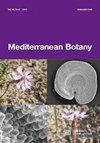Ethnobotanical investigation of 'Chamaerops humilis' in the area of Beni Snous (Western of Algeria)
IF 0.7
4区 生物学
Q3 PLANT SCIENCES
引用次数: 6
Abstract
The ethnobotanical potentials of Chamaerops humilis in the Béni Snous region (south-west of Tlemcen, western Algeria) has been studied to know the therapeutic utilities and the practices of the local populations, in order to valorize this resource. A series of ethnobotanical surveys were carried out using a questionnaire on the 3 municipalities of Beni Snous (Beni Bahdel, Azail, and Beni Snous). The frequency of use of Chamaerops humilis in the region of study is closely related to the profile of the investigated people. The results of this study reveal that Chamaerops humilis parts are used for therapeutic purposes by the local population: the heart of stipe as to treat dyspepsia (gastrointestinal attacks, 93.90%), fruits as an antiseptic (70.73%), roots for anemia (36.55%) and intestinal worms (30.10%), while the leaves are often used to treat diabetes (21.62%) and other gastrointestinal disorders (30.1%).阿尔及利亚西部贝尼斯诺地区“黄斑Chamaerops”的民族植物学调查
对bsamni Snous地区(阿尔及利亚西部特莱姆森西南部)的黄斑Chamaerops humilis的民族植物学潜力进行了研究,以了解当地居民的治疗效用和做法,以便对这一资源进行估价。在贝尼斯诺斯的3个自治市(贝尼巴赫德尔、阿扎伊尔和贝尼斯诺斯)进行了一系列民族植物学调查。研究区域黄chameroops的使用频率与被调查人群的特征密切相关。本研究结果显示,当地居民将其部分用于治疗目的:茎心用于治疗消化不良(胃肠道发作,93.90%),果实用作防腐剂(70.73%),根部用于治疗贫血(36.55%)和肠道蠕虫(30.10%),而叶子通常用于治疗糖尿病(21.62%)和其他胃肠道疾病(30.1%)。
本文章由计算机程序翻译,如有差异,请以英文原文为准。
求助全文
约1分钟内获得全文
求助全文
来源期刊

Mediterranean Botany
Agricultural and Biological Sciences-Plant Science
CiteScore
2.40
自引率
10.00%
发文量
30
审稿时长
12 weeks
期刊介绍:
Mediterranean Botany (ISSNe 2603-9109), formerly Lazaroa, is a biannual journal that publishes original research studies in the field of Botany including plant systematics, vegetation ecology, biogeography, evolutionary biology, ecophysiology, community ecology, ethnobotany and conservation biology on Mediterranean biomes but also in interacting areas.
Mediterranean Botany is an OPEN ACCESS Journal, free of charges for any published article.
 求助内容:
求助内容: 应助结果提醒方式:
应助结果提醒方式:


